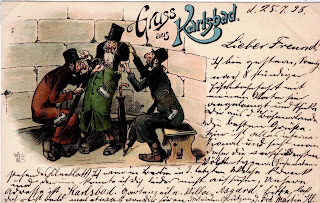Belief Me – A.H. Jewish stereotype postcard
Author: Lawrence –
Location: Chicago, Illinois, USA
These four postcard variants, and probably more exist, all showing the same caricatured image, were printed across different years. Each reflects the commercial humor and visual style of the early postcard era, with subtle differences in production or captioning.
Series overview: The caption Belief Me appears on a group of early 1900s postcards credited as Copyright 1905 – A.H., likely tied to Alfred Holzman of Chicago. Designs exist as paper chromolithographs and as leather postcards burned by pyrography. Numbering of 73, in the lower margin places them, in a commercial humor series from the undivided back era.
Antisemitic Stereotypes Depicted
This postcard features a number of classic antisemitic stereotypes that were commonly used in early 20th-century European and American visual culture. The image and text employ caricature and symbolism to perpetuate harmful, false depictions of Jews, which were typical in period postcards and other forms of popular media.- Physical Caricature: The man is depicted with exaggerated facial features—large nose, thick lips, and round spectacles—traits that have been used in antisemitic iconography to mock Jewish appearance.
- Attire: The figure wears a beard and a skullcap, suggesting the stereotype of the "Eastern European Jew" or Orthodox Jew, feeding into the imagery used to otherize Jewish communities.
- Jewelry: The prominent jewel or medallion on the chest can be linked to stereotypes about Jews and wealth or greed, with the radiant lines around the stone possibly suggesting ostentatiousness or material obsession.
- Smoking Cigar: The smoking cigar, often seen in antisemitic illustrations, can be intended to indicate self-indulgence, showiness, or a louche lifestyle.
- Gestures: The open-handed gesture might be interpreted as a sign of exaggerated speech or persuasion, often used to suggest untrustworthiness or theatricality in antisemitic portrayals.
- Text (“Belief Me”): The pseudo-Germanic phrase “Belief Me,” intentionally misspelled, mocks Jewish accent or manner of speaking, a trope found in English-language antisemitic humor at the time.
Production notes
- Credit line in first postcard reads Copyright 1905 – A.H. with a small series number of 73.
- Printed as chromolithography on paper and as leather postcards using pyrography on deer hide.
Why classify Belief Me as antisemitic?
The humor is built from caricatured features, religious costume cues, wealth markers, and mock accent spelling that invite readers to see Jewishness as comic and untrustworthy.







































